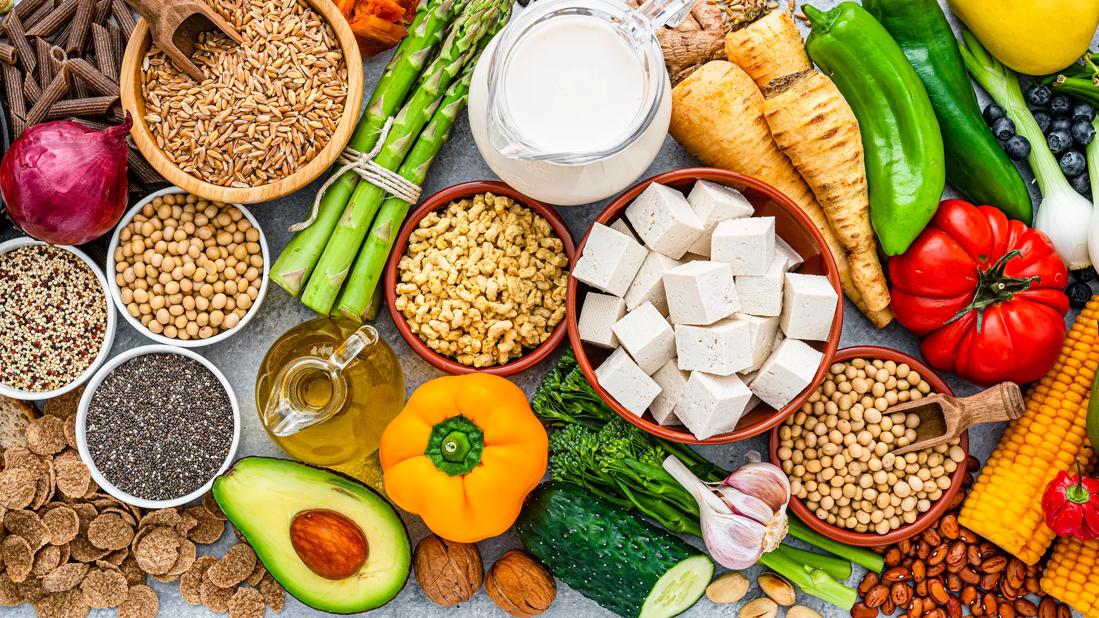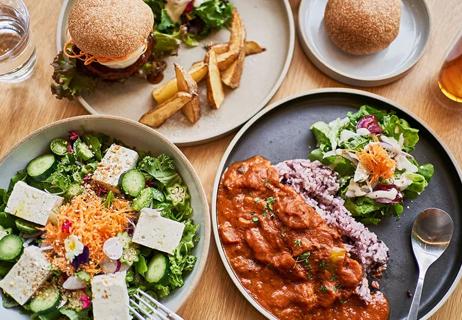The meatless, plant-based eating style has countless tasty and healthy options

So, you’re ready to go vegan.
Advertisement
Cleveland Clinic is a non-profit academic medical center. Advertising on our site helps support our mission. We do not endorse non-Cleveland Clinic products or services. Policy
Maybe you’re no longer feeling OK about eating animals or have certain restrictions from your faith practice. Could be that you’re concerned about the carbon footprint of your last fast-food cheeseburger — or just shocked by its 800 calories and your healthcare provider says it’s time to shape up.
Or maybe it’s just that a certain TikTok influencer has you extra excited for edamame, and you want to see what it’s all about. Or the New Year has rolled around again and you’re amped up to try Veganuary.
Whatever your reason for making the move, we’ve got you covered. We’ll take you through a quick but informative “Vegan Diet 101,” with a big assist from registered dietitian Julia Zumpano, RD, LD.
Let’s start with the basics. What is vegan anyway? And what’s a vegan diet?
“First of all, let’s call it a style of eating, not a diet,” Zumpano clarifies. “Fad diets come and go, but if you’re going to plan and make a change like this, it should be your new style of eating for a healthy life.”
At its most basic, Zumpano says that a vegan eating style is more than just meatless (or devoid of animal products entirely), but also a commitment to eating whole foods and using “food as fuel.”
If followed correctly — wisely substituting whole foods and plant-based foods to adequately replace nutrients lost with the absence of meat and dairy — veganism will leverage the benefits of a vegetarian diet. But Zumpano contends that it’s also just one among a number of far healthier choices than the problematic Standard American Diet (SAD) or Western Diet, which is exceedingly high in fat, sodium and sugar, and low in fruits and vegetables.
Advertisement
“Some eat vegan food to protect the rights of animals, which is why some people may not consume honey and similar products that come from living things,” shares Zumpano. “And while a vegan diet is often associated with a healthier lifestyle, that’s only true when it’s based on whole, plant-based foods.”
If you do completely give up eating animals and animal products, you’ll definitely not be in the majority — fewer than 5% of U.S. adults say they are vegetarian and about 1% say they’re vegan.
And while both of those eating styles are rooted in a plant-based diet, they’re not exactly the same.
For our purposes, we’ll look at dietary vegans — setting aside ethical, religious or environmental vegans — as a dietary vegan’s motivation is primarily health-related. With that in mind, here are a few more vegan variants:
You could look at veganism as a subset of vegetarianism. And there are as many as three, five or even a dozen vegetarian-vegan types, depending on who you ask.
That broader group may include vegetarians who also eat fish (pescatarians). Go even wider and you might include those who eat mostly vegetarian but allow chicken or other white meat (pollotarians) or even those who generally avoid meat but will occasionally have animal products (flexitarians).
Let’s dig a bit deeper into the question of what you’ll eat — and not eat — as a vegan.
Simply put, a vegan eating style means you don’t consume anything that comes from animals, including:
But going vegan doesn’t have to be defined by what it excludes. It could instead be described by some of the great vegan food options out there.
Many of those options are simply tried-and-true foods — from broccoli and apples to whole-wheat pancakes — while others might be a bit new for your kitchen and your tastes (looking at you, tempeh and seitan!).
One way to approach veganism for beginners is to simply scan a good vegan food list for limitless vegan food options. And if it’s more helpful, Zumpano says you can break it down into food group choices that are available to you as a vegan.
Advertisement
A robust list could include:
Advertisement
Oh, and about those highly processed foods marketed as vegan that you see popping up all over your grocery store? Zumpano advises taking a hard pass. “They may not have animal products in the ingredients, but that doesn’t mean they’re good for you,” she says. “A ‘vegan’ chicken nugget may be more processed and worse for you than actual chicken nuggets.”
So, where do you even begin on such an eating-style journey?
Slowly and methodically.
“I recommend that people cut out one thing at a time,” Zumpano says. “For example, cut out red meat for the first month, then poultry the next, then dairy, then eggs and so on. Or you could do it by week instead of month.”
Here’s one path to veganism, eliminating something every week or two, or even monthly if that works for you:
“I like to do it in a step-by-step process because it’s an easier transition. You always have something to fall back on instead of getting rid of too much, too soon,” she adds. “A vegan diet is tough on convenience. But once you have your essential pantry items and a good routine, it’s less of a challenge.”
Advertisement
Zumpano also emphasizes that everyone is different. “Some people may prefer doing it cold turkey. Or you could start by including a couple of meatless meals into your week to replace red meat. The key is building a foundation of good meatless recipes and meals to make the transition easier.”
But it’s equally important to replace as you remove, Zumpano says — particularly important to ensure you’re getting enough protein, iron, omega-3 fatty acids, calcium and B vitamins.
“You’ll need a plant-based source of protein to add in as you remove things,” she notes. “Anytime you have to have a restriction — by choice or for health reasons — that restriction doesn’t have to feel bad and it won’t if you come up with an alternative that you can enjoy.”
It’s also important to know that our body doesn’t absorb plant sources of iron as well as iron from animals. Zumpano recommends pairing plant sources of iron with vitamin C foods, like citrus fruits, strawberries, tomatoes and peppers, to increase absorption.
You’ll also want to be sure to add foods like flaxseed, walnuts, chia seeds, pumpkin seeds and edamame (green soybeans) to boost your healthy fats (omega-3 fatty acids), which are important for heart health and eye and brain development.
To increase calcium, which supports bone health, look for vegan-friendly milk alternatives that are fortified with calcium and other nutrients. Options might include soy, almond, oat, hemp or pea-protein-based milks. Be sure to check nutrition facts and ingredients for calcium, vitamin D and protein, as these can vary greatly based on type and brand.
Other calcium-rich choices include dark, leafy green vegetables, such as spinach, kale, broccoli and collard greens.
Finally, a vegan diet can leave you short of critical B vitamins, especially B12, which helps make red blood cells, prevents anemia and protects nerve cells.
And as you can’t get vitamin B12 from plant sources, you might try fortified breakfast cereals, fortified soy foods (including tofu and soy milk) and multivitamins.
Soy alone has little B12, but its fermented cousin tempeh has a considerable amount. Some research shows that nori (also known as dried purple laver or roasted seaweed) is the best source of B12. You might know it as the wrap around your sushi, but it has plenty of other uses and a taste you can get used to.
And get to know the versatile value of nutritional yeast. This flaky supplement is a great source of vitamin B12 and has a pleasantly cheesy flavor that you’ll enjoy sprinkling on any savory dish. It can even be used as a cheese substitute in recipes.
Just by planning a bit and being intentional about what you add to your menu can address the B12 issue, and give you a few new tastes for your palette.
Another way to approach this eating style could be a day-by-day plan. You could even start with these five Meatless Mondays recipes. And if you’re in the “dessert before dinner” camp, give our chia seed pudding a try. (Zumpano recommends adding blended dates or figs for extra sweetness and an iron boost.)
“Eating a plant-based diet requires planning, but you have a lot of choices to meet all your nutrient needs,” she reassures. “You may just have to take a step out of the norm to get them.”
With that in mind, here’s a five-day plan. And remember, this is hardly the only way to go. If you’re the kind of person who likes routines (or if this seems like a lot of work), there’s nothing wrong with the same breakfast most days — or every day! — or spreading some of the entrees over two days.
And those are just a few great vegan recipes. There are hundreds more out there and even vegan food delivery services if you need some help at the start.
Going vegan is a journey that may seem daunting at first, but like any habit, it gets easier the longer you go. Everything will eventually begin to look different — from the layout of your local grocery store (your eyes will pop at row upon row of processed foods once you really begin to look).
But it can be worth it, Zumpano encourages, if you plan your journey thoughtfully, stick to the basics of eating real food and make sure that you and your family (if they’re coming along for the ride) are getting the nutrients we all need to live and thrive.
Learn more about our editorial process.
Advertisement

Eating a totally plant-based diet can be healthy, but eating a well-balanced diet no matter what eating style you choose is important

Going vegan in January can help you lose weight, lower your blood pressure and more

The small red fruit is a good source of potassium and vitamin C — and may support your gut and brain health

This root veggie can also benefit your gut, heart and eyes

This color additive, found in many pre-packaged foods, may affect people with ADHD or allergies

Eating too much salt can put extra pressure on your blood vessels and heart

Tart cherry juice contains natural compounds that may support better sleep

This fruit has clear nutritional benefits — but there’s little evidence it can prevent or treat illness

Babies can get congested easily, but you can calm their cough by keeping them hydrated, using nasal drops and running a humidifier

Weight loss may cause loose, sagging skin and muscle loss to your rear

Several conditions, like vitiligo and fungal infection, can cause a loss of pigmentation, leading to white spots or patches on your skin